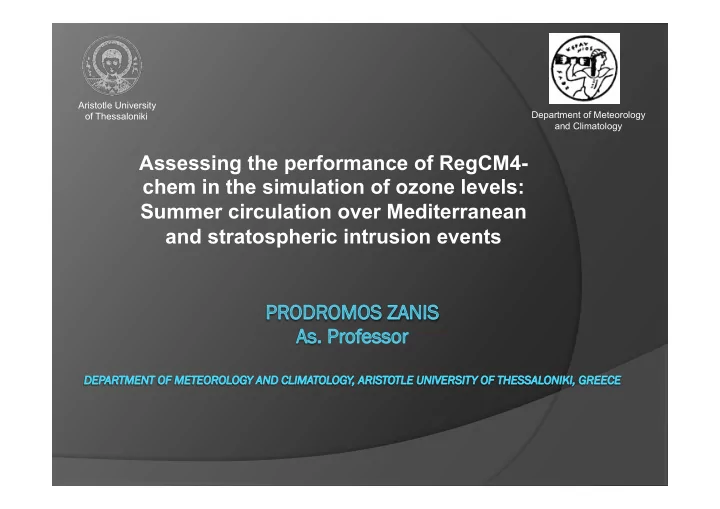

Aristotle University Department of Meteorology of Thessaloniki and Climatology Assessing the performance of RegCM4- chem in the simulation of ozone levels: Summer circulation over Mediterranean and stratospheric intrusion events
Acknowledgments
Range of global CTM estimates for the O3 budget Strat-trop exchange 300 - 1100 Tg/yr Photochemical prod. 3000 - 5000 Tg/yr Photochemical dest. 2500 - 4300 Tg/yr Net chemistry -500 +600 Tg/yr Deposition 500 - 1200 Tg/yr Tropospheric burden 280 - 400 Tg von Kuhlmann et al., J. Geophys. Res., 2003.
Global aspect of STE (Stohl et al., JGR, 2003) 10 Large-scale Large-scale ascent subsidence Extratropical pump 30 100 380 K 300 1000 Tropics Polar region Middle Latitudes
ERA-interim vs TES O 3 in July-August (2005-2009) Zanis et al., ACP, 2014 a) ¡ b) ¡
The he E EMME s summe mmer c circula lation
July – August Tropopause folds (Tyrlis et al., JGR, 2014) SHALLOW MEDIUM
ERA-interim latitude –altitude cross sections at 25 E of O 3 , PV, SH and W in July-August (1998-2009) Zanis et al., ACP, 2014
RegCM4 configuration Dynamic core (Grell et al., 1994) Radiative scheme: NCAR CCM3 (Kiehl et al., 1996) or RRTM (Iacono et al., 2008) Convective Precipitation Schemes: Modified-Kuo scheme (Anthes, 1977) or Grell scheme (Grell, 1993) or MIT-Emanuel scheme (Emanuel, 1991) or Tiedke scheme Tiedke and Emanuel schemes offer a more detailed treatment of convective transport than the simple mixing hypothesis used with the other schemes. Surface model: BATS (Dickinson et al., 1993) or CLM (Oleson et al., 2008) Planetary Boundary Layer Scheme: Holtslag PBL (Holtslag et al., 1990) or UW Turbulence Closure Model (Grenier and Bretherton, 2001) Large-Scale Precipitation Scheme: SUBEX (Sundqvist et al., 1989) Initial and Boundary Conditions: meteorology ERA-interim, GTOPO30 Terrain and GLCC Landuse datasets, SSTs ERA-interim
Coupled aerosols and gases in RegCM4 Gas phase chemistry: CBMZ scheme with 35 species Natural aerosols Dust aerosols: 4 dust bins (Zakey et al., 2006) q (12 dust bins under development) q Sea salt aerosols: 2 sea salt bins (Zakey et al., 2008) Anthropogenic aerosols (Solmon et al., 2006) Hydrophilic SO 2 SO 4 -- BC (soot) Hydrophobic 6 Tracers Hydrophilic OC T (primary + secondary) Hydrophobic Emissions: CMIP5 RCP anthropogenic emissions 1990-2010 Chemical BCs: CAM+EC-EARTH for aerosols, MOZART CTM climatology 2000-2007 for gases, Monthly
Aerosols and gases in RegCM4 General approach Tracer model / RegCM4 ∂ χ V F F T S R R D Q Q ∑ = − ⋅ ∇ χ + + + + − − − + − H V CUM w , ls w , cum dep p l χ t ∂ Primary Removal Physico – Transport Emissions terms chemical transformations Strongly dependent on the nature of the tracer
EMEP:48.5±10.7 ppbv (7.5±8.7) RegCM4: 54.6±13.5 ppbv (11.1±10.1) MACC: 46.8±11.2 ppbv (13.01±7.7) RegCM4 vs EMEP EMEP:53.1±8.5 ppbv (6.9±9.6) RegCM4: 61.4±10.2 ppbv (6.8±8.3) MACC: 59.0±8.3 ppbv (10.9±8.3) MACC vs EMEP EMEP:49.5±7.9 ppbv (5.3±7.3) RegCM4: 56.0±8.2 ppbv (7.1±8.1) MACC: 49.0±6.7 ppbv (9.1±6.4) MACC vs RegCM4
O3 fields in RegCM4 and MACC reanalysis for summer 2006 RegCM4-Chem MACC reanalysis JJA 2006 JJA 2006
SH fields in RegCM4 and MACC reanalysis for summer 2006 RegCM4-Chem MACC reanalysis JJA 2006 JJA 2006
Ozone cross sections in RegCM4 and MACC reanalysis RegCM4-Chem MACC reanalysis JJA 2006 JJA 2006
Key remarks 1 There is enhanced ozone over Eastern Mediterranean and Middle East (EMME) which is a robust feature, propagating down to lower free tropospheric levels. This is linked the downward transport from the UTLS region associated with the enhanced subsidence and TP folds that dominates the summertime EMME circulation. RegCM4-chem simulations capture the ozone pool pattern over EMME. Discrepancies in upper troposphere between RegCM4 and MACC could be linked to differences in top chemical boundary conditions.
A deep stratospheric intrusion event down to earth ’ s surface of the megacity of Athens - 9 October 2003 (Akritidis et al., MAP, 2010) 60 Ozone concetrations (ppb) 50 40 Elefsina Magoula 30 Mandra October 2003 20 10 0 21:00 0:00 3:00 6:00 9:00 12:00 15:00 18:00 Time (UTC) Near surface O 3 measurements ECMWF
RegCM4 – Geopotential Height at 500 hPa 8-9 October 2003 (b) 00 Z - 9 October (a) 18 Z - 8 October (c) 06 Z - 9 October (d) 12 Z - 9 October
RegCM4 – Wind Speed at 300 hPa 8-9 October 2003 (b) 00 Z - 9 October (a) 18 Z - 8 October (c) 06 Z - 9 October (d) 12 Z - 9 October
RegCM4 – Ozone at 500 hPa 8-9 October 2003 (b) 00 Z - 9 October (a) 18 Z - 8 October (c) 06 Z - 9 October (d) 12 Z - 9 October
RegCM4 – Specific Humidity at 500 hPa 8-9 October 2003 (b) 00 Z - 9 October (a) 18 Z - 8 October (c) 06 Z - 9 October (d) 12 Z - 9 October
RegCM4 – O3 and SH lon-pres cross sections 8-9 October 2003 (b) 00 Z - 9 October / O3 (a) 18 Z - 8 October / O3 (c) 18 Z - 8 October / SH (d) 00 Z - 9 October / SH
RegCM4 – O3 lat-pres cross sections 00 Z - 9 October 2003 (a) Ptop = 50 mbar (b) Ptop = 100 mbar c) differences 100-50
Key remarks 2 The ability of RegCM4-chem to simulate a deep stratospheric intrusion (9 October 2003) and its impact on tropospheric ozone levels was investigated. RegCM4-chem captures adequately the evolution of the event and indicates transport of dry and rich in ozone air masses to lower tropospheric levels. Prliminary analysis of the model ’ s sensitivity to the top model level indicated higher ozone around the tropopause fold in the upper tropoposhere in the simulation with the lower top of the atmosphere. No significant impact in lower tropospheric levels.
Department of Meteorology and Climatology AUTH Thanks for your attention
Recommend
More recommend